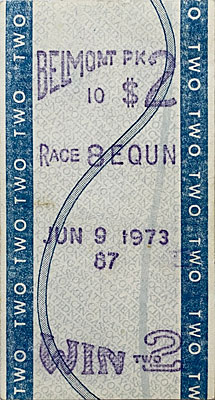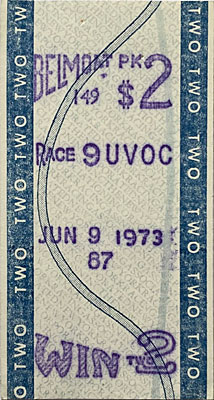On April 3, 1972, the front page headline in the Morning Telegraph read, "Head of the River Wins Everglades Stakes." It looked as if the colt's owner Rokeby Stable and trainer Elliott Burch had another top 3-year-old on the Kentucky Derby (G1) trail to follow their champon Arts and Letters. What made this headline so significant was that it would be the final issue ever published of the Morning Telegraph, racing's bible since 1897. So Head of the River had secured a very small niche in the journalistic history of racing.
Head of the River never did live up to his promise, but that's not to say he didn't play another small part in history that most people are unaware of. That small part was his participation in a 1 1/16-mile allowance race on grass at Belmont Park on June 9, 1973. It wasn't about where he finished or who he ran against or anything regarding the running of the race.
It was all about when the race was run and who rode him. You see, that insignificant allowance event was the race following Secretariat's historic victory in the Belmont Stakes (G1), in which he became racing's first Triple Crown winner in 25 years and set a record that will last forever, while winning by a staggering 31 lengths. But what made this allowance race so interesting is that Head of the River was ridden by none other than Ron Turcotte, who had just piloted Big Red to his record-setting victory that still gives people goose bumps after 47 years.
So, why in the world would Turcotte, still on cloud nine and basking in the blinding limelight of his history making victory, ride in the race following the Belmont Stakes? After all, that was to be a time of unbridled jubilation and celebration. How do you come down from the highest of highs to the reality of an insignificant allowance race in less than 30 minutes?
Imagine the reaction of the media, instead of pounding away on their typewriters to chronicle this history-making event, having to wait for the last race to be run before they could get quotes from the rider of the Triple Crown winner, especially one as high-profile as Ron Turcotte.
As it turned out, Turcotte could have backed out of the mount but his integrity superseded all else.
“When they do the draw in the morning, you entered you’re horse, but you don’t know where they’re going to place it on the program,” Turcotte recalled. “After I found out it was going to be the race after the Belmont it never entered my mind to take off the mount. Sam Kanchugar, who ran the NYRA press office, was all over me, telling me, ‘You’re all clear, you can take off the mount.’ It was all OK’d by the stewards, but I just couldn’t do it to (Elliott). I felt it was an obligation. I had given him the call, and a man is only as good as his word.”
So instead of rejoicing and soaking in all the pandemonium and being surrounded by hordes of media after his history-making ride, here was Turcotte rushing back to the jocks’ room, slipping out of the Meadow Stable silks and putting on the Rokeby Stable silks to ride in an allowance race. With Belmont still reverberating from the spectacle they had just witnessed, Turcotte calmly walked to the paddock with the other riders and admitted he didn’t pay much attention to the people gathered around the walking ring, as he was now totally focused in on Head of the River.
There was an episode of “The Honeymooners,” where Ralph wins an award as the safest bus driver. Norton offers to drive to the ceremony at City Hall to avoid something fateful happening, but Ralph insists on driving, and of course gets into an accident.
Well, life came close to imitating art when Head of the River stepped in a hole on the grass course at the half-mile pole and stumbled, going to his knees. “That was the only time I regretted taking the mount, when the horse hit that hole,” Turcotte said.
As it turned out, Head of the River tired badly after his incident, finishing a well-beaten fifth at odds of 9-2. Ironically, the horse who was outside him at the time and who would finish second at 12-1 was named Big Red L. The winner, Tree of Knowledge, an up-and-coming son of Dr. Fager, went on to win the Hollywood Gold Cup (G1).
After his close call, Turcotte was finally confronted by several media members to get their long-awaited post-race interview.
“After the races, people were waiting for me in the parking lot to sign their programs and stuff like that,” Turcotte said. “I wound up signing for an hour or more.”
It had been a long day, with the anticipation of history being made. Secretariat was feeling good all morning and it was obvious to everyone at the barn he was sitting on a monster performance. Turcotte, as was his custom, walked the track, probing it with a knife to see how deep it was and where the best part of the track was. The way Big Red ran, none of that was needed. The best part of the track was wherever he stepped. Yes, it was fast, but he made it faster. This may have been the only case ever where a horse sprinted a mile and a half.
Turcotte had gotten a good feel of the track, winning an allowance race on Spanish Riddle for Lucien Laurin in the fifth race. And he rode the infamous stablemate Angle Light against Forego in an allowance race in the seventh race.
A crowd of 67,605 showed up, and according to Turcotte, it would have been higher had the race not been so overpublicized that many people, afraid of the traffic, elected to stay home.
So ended the most memorable day of Turcotte’s life on the racetrack. Most jockeys in his position would never have ridden the race after the Belmont. But to Turcotte, there is one thing that takes precedence over everything else – his word.


A souvenir pairing that no one has -- Ron Turcotte's final two mounts on Secretariat (left) and Head of the River




